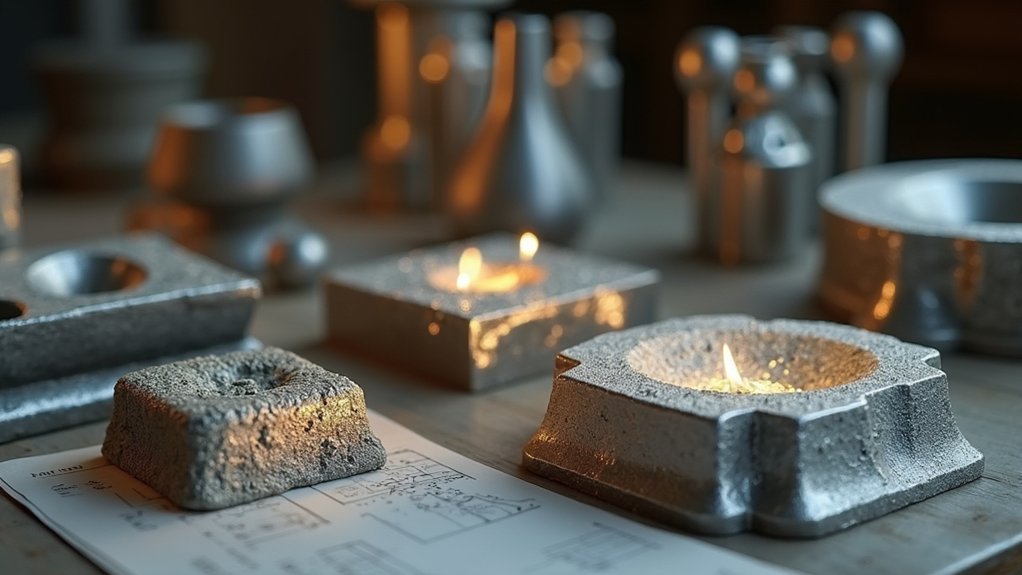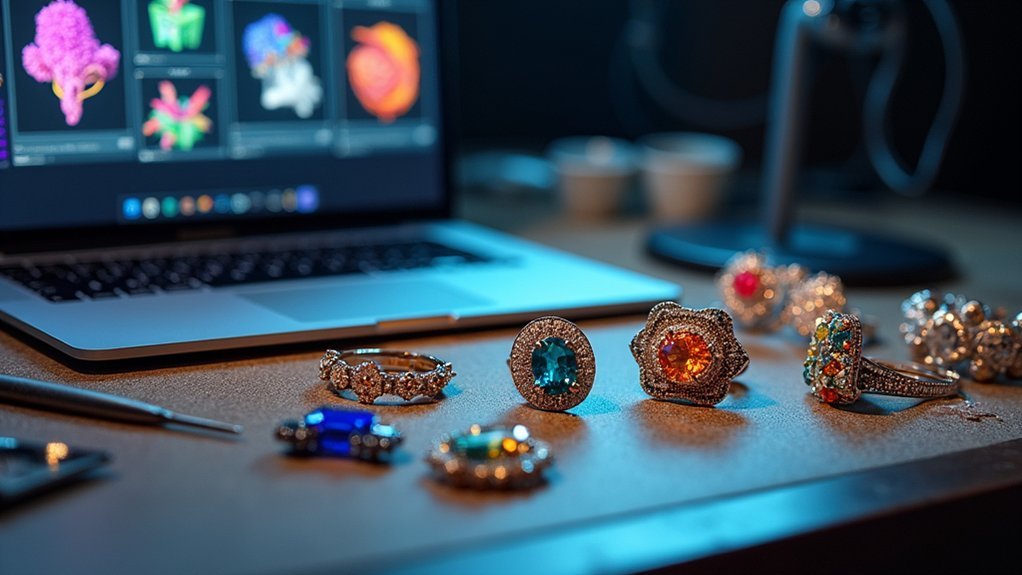You’ll achieve casting certification success by mastering seven essential techniques: perfect your lost wax casting fundamentals with precise temperature control between 1,200°F-2,500°F, maintain exact water-to-material ratios during investment mixing, optimize burnout schedules with gradual temperature changes, control metal pouring temperatures at 1,300°F-1,500°F, systematically troubleshoot common defects, implement rigorous quality control standards, and document every process step for compliance. These professional-grade methods separate certified experts from amateurs and reveal advanced strategies that guarantee consistent results.
Master Lost Wax Casting Fundamentals

Three fundamental stages define the lost wax casting process that you’ll need to master for certification success.
First, you’ll create a detailed wax model, then cover it with refractory material that hardens into a mold. During the investment casting phase, you’ll melt out the wax, leaving a precise cavity for metal pouring.
Temperature control becomes critical when heating your metal to its specific melting point, ranging from 1,200°F to 2,500°F depending on your chosen alloy.
Precise temperature management separates successful casters from beginners when working with metals requiring heat ranges up to 2,500°F.
You’ll achieve detailed shapes with smooth surfaces that make lost wax casting ideal for complex projects.
After breaking away the mold to reveal your cast metal piece, you’ll complete essential finishing processes including polishing and grinding to achieve professional results.
Perfect Investment Mixing and Preparation
Once you’ve mastered the wax modeling phase, your attention must turn to achieving the perfect investment mix that’ll determine your casting’s final quality.
Investment mixing requires precise water-to-material ratios for ideal consistency that flows easily while maintaining structural integrity. You’ll need thorough mixing to eliminate lumps that create casting imperfections and compromise mold strength.
Vacuum mixing proves essential for removing air bubbles, ensuring smooth surface finishes in your final cast. Allow 30-60 minutes setting time for proper hardening and dimensional accuracy, depending on your investment material.
Success demands calibrating mixing equipment regularly and measuring materials precisely. This consistency minimizes quality variability and greatly increases your certification process success rate.
Master these fundamentals to produce professional-grade castings every time.
Optimize Burnout Schedules for Clean Casting

While investment preparation sets the foundation for quality casting, your burnout schedule determines whether you’ll achieve the clean, defect-free results essential for certification success.
Optimization of the curing process requires careful monitoring of environmental conditions throughout each phase. You’ll need structured schedules that allow gradual temperature changes, preventing shrinkage cracks and maintaining casting quality.
Monitor humidity and temperature fluctuations consistently during burnout to eliminate defects.
Combine appropriate curing compounds with your schedule to enhance surface finish and overall aesthetics. The casting process benefits greatly from adjusting schedules based on specific material properties and project requirements.
Regular reviews and modifications of your burnout protocols lead to improved performance and long-lasting results that meet certification standards.
Control Metal Temperature and Pour Techniques
After perfecting your burnout schedule, the next critical factor in achieving certification-ready castings lies in maintaining precise metal temperature and executing controlled pour techniques.
You’ll need to keep your metal temperature between 1300°F to 1500°F during the pouring process to guarantee ideal flow and prevent defects like cold shuts. Preheating molds helps minimize thermal shock that can crack your casting.
When filling complex molds, use controlled pouring speed and proper angles to reduce turbulence and air entrapment. Monitor your cooling rate carefully after pouring, as rapid cooling creates uneven solidification and residual stresses.
These temperature control measures directly impact your casting quality and certification success rates.
Troubleshoot Common Casting Defects

Even with perfect temperature control and pouring techniques, casting defects can still crop up and derail your certification goals. You’ll need proper mixing techniques and vibration methods to eliminate trapped air that creates bubbles. For shrinkage cracks, strategically place control joints and consider shrinkage-reducing admixtures.
| Defect Type | Cause | Solution |
|---|---|---|
| Air Bubbles | Poor mixing, trapped air | Use vibration, proper mixing techniques |
| Shrinkage Cracks | Material movement | Install control joints, use admixtures |
| Delamination | Rapid drying | Maintain proper curing conditions |
| Inconsistent Finish | Temperature fluctuations | Keep consistent temperature during curing |
| Curling/Cracking | Environmental factors | Monitor conditions, adjust mix properties |
Understanding environmental conditions helps you troubleshoot issues before they compromise high-quality casting results.
Implement Quality Control and Finishing Standards
Since troubleshooting defects addresses problems after they occur, implementing robust quality control measures prevents issues from developing in the first place.
You’ll need systematic inspection protocols throughout your casting process, including slump tests and compressive strength assessments to verify your concrete mix meets standards.
Establish clear finishing standards that define surface texture and appearance criteria, ensuring project quality aligns with client expectations.
Use specialized techniques like proper troweling and polishing to enhance durability and aesthetics.
Document any deviations immediately and implement corrective actions promptly.
This approach enables continuous improvement in your casting practices while maintaining consistent adherence to specifications, ultimately reducing defects and elevating overall project outcomes.
Document Your Process for Certification Requirements

You’ll need to establish essential documentation standards that capture every aspect of your casting process from initial breakdowns to final selections.
Your compliance record keeping must include detailed audition logs, feedback notes, and decision rationales that demonstrate your professional methodology to certification bodies.
These thorough records won’t just satisfy certification requirements—they’ll also improve your casting effectiveness by helping you identify patterns and refine your techniques over time.
Essential Documentation Standards
Three critical components form the backbone of certification-ready casting documentation: thorough session records, systematic communication tracking, and standardized process templates.
These essential documentation standards guarantee casting directors meet certification requirements while maintaining transparency and traceability throughout their casting process.
Your documentation must capture every detail that demonstrates an actor’s ability and your decision-making rationale:
- Comprehensive session records – Include audition notes, feedback on actors’ ability, and detailed selection criteria for each casting breakdown.
- Complete communication logs – Document all exchanges with actors, agents, and collaborators to establish clear timelines.
- Standardized templates – Create consistent formats for casting breakdowns and decision processes.
- Systematic tracking methods – Monitor technique evolution and implement changes based on industry best practices.
Regular reviews guarantee your documentation stays aligned with evolving certification requirements.
Compliance Record Keeping
Meticulous compliance record keeping transforms your casting documentation into a certification-ready system that withstands rigorous industry scrutiny. You’ll establish detailed logs capturing dates, participants, and casting techniques while organizing audition materials with clear selection criteria. Industry standards demand thorough documentation of decision-making processes.
| Documentation Type | Required Elements | Storage Method |
|---|---|---|
| Casting Logs | Dates, participants, techniques | Digital filing system |
| Audition Records | Materials, feedback, criteria | Cloud-based storage |
| Selection Documentation | Decision rationale, scoring | Encrypted databases |
| Compliance Reviews | Updates, changes, assessments | Version-controlled files |
You’ll implement digital filing systems to streamline access during audits. Regular review and update cycles guarantee your records reflect current practices and certification requirements. Industry-standard templates maintain consistency across all documentation, creating bulletproof compliance records.
Frequently Asked Questions
How to Impress a Casting Agent?
You’ll impress casting agents by thoroughly preparing your character’s background, developing strong cold reading skills, maintaining professional eye contact, channeling nerves into emotional range, and actively incorporating feedback to demonstrate your commitment to continuous improvement.
What Makes Good Casting?
You’ll create successful casting by thoroughly analyzing scripts, conducting effective auditions with chemistry tests, building supportive environments for actors, staying current with industry trends, and collaborating with your team on decisions.
How Do Casting Directors Find Talent?
You’ll find talent through casting websites, social media platforms, and networking with agents. You’ll attend industry events and workshops to discover emerging actors, then conduct auditions and chemistry tests.
What Is the Meaning of Professional Casting?
Professional casting means you’re systematically selecting actors for roles through structured auditions, collaborating with directors and producers, networking with agents, and maintaining industry professionalism to guarantee the best talent matches your production’s character requirements.
In Summary
You’ll achieve certification success by mastering these seven casting techniques consistently. Don’t rush through investment mixing or burnout schedules—precision here prevents costly defects later. You’re building muscle memory with each pour, so practice your temperature control and metal handling religiously. When problems arise, you’ll troubleshoot faster because you understand the fundamentals. Document everything meticulously; your process records demonstrate competency to certification boards and help you refine your technique continuously.





Leave a Reply